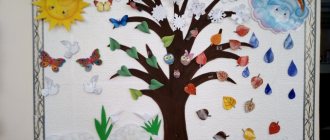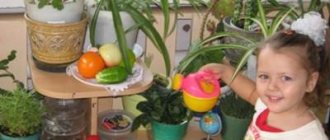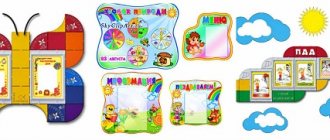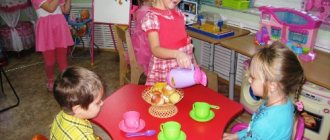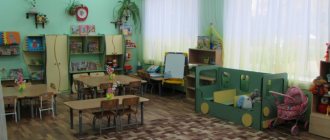“Transformability of space in kindergarten”
Transformability of space in kindergarten
Transformability of space -
the possibility of changing the subject-spatial environment depending on the educational situation, including the changing interests and capabilities of children.
When organizing direct educational activities, you need to use mobile material, which is constantly varied and modified, which allows you to enrich the plots of games and diversify the educational space of the group. Objects and toys with which a child acts are not just objects of his attention, but means of communication with adults and children.
The principle of transformability of the environment in groups is implemented through variability depending on the age characteristics of children, the period of study, and the educational program being implemented.
Transformability principle
1. It is necessary to have lightweight structures
, modules, screens, tents, light benches, modular furniture, curtains and other devices that can be easily changed functionally. For example: the teacher pulled back the curtain, and then closed the topic of the project with clarity - and this visual material does not prevent the children from concentrating on designing, and children can easily design the same curtain as a “billboard” for their activities or use it for an exhibition of their works). These same designs will allow children to independently arrange the space at their own discretion, to choose, equip or inhabit it at their own discretion, to build their own little world. This is especially true for imaginative play. The possibility of transforming space, including that performed by children, can also be realized through the use of sliding (and unrolling roller) partitions.
2. Furniture height
in kindergarten it should be easy
to change.
You need to get away from:
- Wall decoration and decorative elements should be changeable and understandable to preschoolers;
- fixed front arrangement of tables and chairs;
- stationary placement of gaming corners for story games with fixed themes and plots (“Kitchen”, “Hospital”, “Shop”, “Hairdresser”. The content of the gaming corner should be more mobile and regularly updated.
The construction of a subject environment is the external conditions of the pedagogical process that make it possible to organize the child’s independent activity, aimed at his self-development under the supervision of an adult. It is important that the subject environment has the character of an open, non-closed system, capable of change, adjustment and development. In other words, the environment is not only developing, but also developing. Practice suggests that it is difficult to completely replace the subject environment in a group. But still, under any circumstances, the objective world surrounding the child must be replenished and updated. Only then does the environment contribute to the formation of cognitive, speech, motor and creative activity.
The environment should provide light, movable, portable structures that enable children to create space for play in a convenient place - platforms on wheels, small podiums on wheels, portable playground corners made of a plastic base, which can also serve as screens.
The idea of mobility and dynamism can be easily realized with the help of a screen. It allows children to escape from the world of adults and settle in their own “nest”.
Transformable screens have been made for games: (steamboat, car, military vehicle, girls' room), which allows you to use gaming equipment in different ways. Screens have two and three doors, they are light and safe to use.
The “Machine” screen can serve as a plot for games and allows the child to limit his play area. The wheels and awning of the machine are removable, which makes it easy to store the screen.
The “Boat” screen for boys can have an angular shape. A child can upgrade it with the help of attached paraphernalia, and marine-themed items (anchor, steering wheel, lifebuoy) will help quickly organize the game.
It is enough to replace the fabric covering and it is no longer a ship, but a military vehicle or a headquarters for commanders. Children can act on their own depending on the game plan. Screens for boys allow you to change the subject-spatial environment and introduce new things into it in accordance with the interests of the children. All the boys' favorite items can be easily attached and placed in their pockets: watch, walkie-talkie, flashlight, map, binoculars. They also easily accommodate carpentry and joinery tools: a hacksaw, a hammer, a screwdriver. And the flirtatiously elegant screen for girls seems to emphasize the serious nature of the boy’s screen.
Screen for girls can
made of a light veil, which is gathered so that it resembles the shape of a light airy skirt. The screen is complemented with attributes for a little lady (chest, hat, beads, umbrella).
The screens are convenient to store and easy to fold, allowing you to carry them. Screens are multifunctional and versatile.
Soft modules enrich children's play and provide transformability and multifunctionality of the play space. At the discretion of the players, it can be a rocket, a swimming pool, a palace, a bus, etc.
The fullness of the subject-developmental environment allows children to experience an event each time in a new situation, environment, which develops fantasy and imagination, allows them to master the means of communication and ways of interacting with adults and peers.
Making the playing field:
“Forest glade”, equipped with a set of small toys that can be used in different settings (farm, village, park, etc.), in accordance with the children’s play plans. Children can add ready-made models or build the necessary structures from various construction sets, use substitute objects, and homemade toys.
“The Road” helps to consolidate and embody children’s personal social experience in the game, immersion in the game situation, showing ingenuity in using the subject environment, performing a variety of game actions, and complementing the game environment as the game progresses.
PROJECT “TO CREATE A TRANSFORMABLE SUBJECT-DEVELOPMENT ENVIRONMENT IN A PREPARATORY GROUP.”
Municipal budgetary preschool educational institution "Kindergarten No. 49"
PROJECT
“TO CREATE A TRANSFORMABLE SUBJECT-DEVELOPMENT ENVIRONMENT IN A PREPARATORY GROUP.”
Developed by:
Druzhinina Elena Alexandrovna
Berezniki, 2017
1
.Relevance of the project: The problem of the RPPS group does not fully meet the requirements of the Federal State Educational Standard for Educational Education, and does not fully realize the educational potential of the group space.
To create a subject-development environment that is adequate to the program being implemented, corresponding to the characteristics of the pedagogical process and the creative nature of the child’s activity, this will effectively contribute to the formation of the basis of children’s personal culture, the development of their individuality with various spheres of culture. The transformability of space implies the possibility of changes in the subject-spatial development environment depending on the educational situation, on the changing interests and capabilities of children. The idea of mobility and dynamism can be easily realized with the help of a screen. It allows children to escape from the world of adults and settle in their own “nest”. For this, easily movable multifunctional screens and movable furniture (modules) are used. To interest parents in organizing a subject-development environment. Project type: Variable, practice-oriented 2.I
stage – Stages of work on creating RPPS 2.1.At the first stage, we studied the regulatory documents: Federal State Educational Standards Law on Education 1.In accordance with paragraph 6 of part 1 of article No. 273-F3 “On education in Russian Federation".
2.Order of the Ministry of Education and Science of the Russian Federation.” October 17, 2013 No. 1155. On approval of the federal state education standard for preschool education. Vasilyeva's program. 3. the law “On Education” of SanPiN, the program that is implemented in the preschool department, the Federal State Educational Standard, etc., each teacher creates conditions for children to stay in the group. Thus, when creating the RPPS DU, it is necessary to make changes in accordance with the Federal State Educational Standard according to the requirement of transformability. 2.2 The second stage of work was the monitoring of the PPRS for compliance with the transformability requirement. Self-assessment cards with specific indicators characterizing the quality of the RPPS were developed. Based on the results of the self-assessment, the RPPS made the following conclusions: - it is not sufficiently accessible for changes by the children themselves, - there is a lack of centers taking into account the gender characteristics of children and the conditions for constant changes in the environment. — insufficiency of modern equipment, toys, and equipment for the development of preschool children. Thus, a number of problems were identified: - there is insufficient modern interactive equipment - it is not always possible to transform the space depending on the educational environment. Based on the analysis of the subject-developmental environment of the preschool educational institution and to solve the identified problems, we developed the project “Model of a modern developmental subject-spatial environment in a preschool institution in accordance with the Federal State Educational Standard”, the goals, objectives, content of activities and activities within the framework of the project were determined, distributed responsibilities of participants in the educational process. Goal: creating conditions for the full development of preschool children in all educational areas of the Federal State Educational Standard in accordance with the requirements of transformability. Project objectives:
1. Studying problems and setting project goals.
1. Modernization of the group environment, creation of components of a single individualized space. 2. Optimization of the playing space; rational location of centers for different types of children's activities. 3. Preparation of materials on the project topic: creation of a material base for methodological support of the project (photo materials, list of references, methodological recommendations for educators, selection of material for working with parents. 4. Study of sanitary standards and requirements. 5. Selection of optimally acceptable design options group room. 7. Study of literature on the topic: “Modern requirements for the creation of a subject-development environment in a preschool educational institution." Participants: teachers, parents, preparatory group students. Scale: short-term (3 months). Project implementation plan:
“There is no aspect of upbringing, understood as a whole, that is not influenced by the situation, there is no ability that is not directly dependent on the concrete world immediately surrounding the child...
Anyone who manages to create such an environment will make his work easier to the highest degree.
Among her, the child will live and develop his own self-sufficient life, his spiritual growth will be accomplished from himself, from nature...” E. I. Tikheyeva.
The issue of organizing a subject-developmental environment in preschool education today is particularly relevant. This is due to the introduction of the new Federal State Educational Standard (FSES) to the structure of the basic general education program of preschool education, including requirements for the organization and updating of the subject-development environment of a preschool institution. It is important to correctly approach the issue of creating a subject-developing environment. A developmental subject-spatial environment should be understood as a natural, comfortable environment, rationally organized in space and time, saturated with a variety of objects and gaming materials.
1. Requirements for a developing subject-spatial environment in accordance with the Federal State Educational Standard.
A developing subject-spatial environment ensures maximum realization of the educational potential of the group space.
A developing subject-spatial environment should provide the opportunity for communication in joint activities of children and adults, physical activity of children, as well as opportunities for solitude.
The developing subject-spatial environment should provide:
implementation of various educational programs;
- in the case of organizing inclusive education - the necessary conditions for it;
- taking into account the national, cultural and climatic conditions in which educational activities are carried out; taking into account the age characteristics of children.
A developing subject-spatial environment must be content-rich, transformable, multifunctional, variable, accessible and safe.
- The richness of the environment must correspond to the age capabilities of the children and the content of the Program.
The educational space must be equipped with teaching and educational means (including technical ones), relevant materials, including consumable gaming, sports, health equipment, inventory (in accordance with the specifics of the Program).
The organization of the educational space and the variety of materials, equipment and supplies (in the building and on the site) should ensure:
- playful, educational, research and creative activity of all pupils, experimenting with materials available to children (including sand and water);
- motor activity, including the development of gross and fine motor skills, participation in outdoor games and competitions;
- emotional well-being of children in interaction with the subject-spatial environment;
- The transformability of space implies the possibility
changes in the subject-spatial environment depending on the educational situation, including the changing interests and capabilities of children;
3. Multifunctionality of materials implies:
- the possibility of varied use of various components of the object environment, for example, children's furniture, mats, soft modules, screens, etc.;
- the presence in the Organization or Group of multifunctional (not having a strictly fixed method of use) objects, including natural materials, suitable for use in various types of children's activities (including as substitute objects in children's play).
- Environmental variability suggests:
- the presence in the Organization or Group of various spaces (for play, construction, privacy, etc.), as well as a variety of materials, games, toys and equipment that ensure free choice for children;
- periodic change of play material, the emergence of new objects that stimulate the play, motor, cognitive and research activity of children.
- Availability of the environment assumes:
- accessibility for pupils, including children with disabilities and children with disabilities, of all premises where educational activities are carried out;
- free access for children, including children with disabilities, to games, toys, materials, and aids that provide all basic types of children’s activities;
- serviceability and safety of materials and equipment.
- The safety of the subject-spatial environment presupposes the compliance of all its elements with the requirements for ensuring the reliability and safety of their use.
The organization independently determines the teaching aids, including technical, relevant materials (including consumables), gaming, sports, recreational equipment, inventory necessary for the implementation of the Program.
2. Functions of the educational environment of a preschool educational institution
The basic patterns of upbringing and training of preschool children make it possible to formulate the functions of the educational environment of a preschool educational institution in accordance with the preschool educational institution program.
- The function of stimulating children's activity is based on the goal of offering the child a variety of material for his active participation in various types of activities.
- Information function.
The necessary level of information content of the environment at different stages of the development of the child’s personality is ensured by the variety of topics, the enrichment of the functional properties of its elements, the completeness and diversity of its elements.
- Function of maintaining psychological health.
The environment is the most important factor for a child, influencing his emotional state.
The content of materials and equipment, their placement, and the layout of the premises should evoke positive emotions and make it possible to find a convenient place for both collective (“free space”) and individual (“solitude corner”, etc.) activities.
- The educational function of the environment does not require special decoding. The environment itself is the very center where bonds of cooperation, positive relationships, organized behavior, and caring attitude are born.
- The developmental function of the environment is the leading one. Only then can an environment claim the high title of developmental when it contains material that is feasible for every child, when it provides steps for the very advancement that we are talking about, meaning development. The developmental function of the subject environment requires for its implementation a combination of traditional and new, unusual components, which ensures the continuity of the development of activity from its simple forms to more complex ones.
3. The subject-developmental environment of a preschool educational institution as a condition for the successful socialization of a preschool child.
3.1 The influence of the subject-development environment on the development of the child’s personality.
A properly organized subject-developmental environment in a preschool institution (in a group) provides each child with equal opportunities to acquire certain personality traits and opportunities for his comprehensive development. But not every environment can be developmental.
The space organized for children in an educational institution can be both a powerful stimulus for their development and an obstacle that prevents the manifestation of individual creative abilities.
Targets for completing preschool education are clearly outlined in the educational standard. A child must have initiative and independence in various types of children's activities, the ability to choose an occupation, partners, to generate and implement various plans, be confident in his abilities and open to the outside world. Therefore, the subject-spatial environment that stimulates the child’s communicative, playful, cognitive, physical and other types of activity should be organized depending on the age specifics of his development.
The objective world of childhood is not only a play environment, but also an environment for the development of all specific children’s activities (A.V. Zaporozhets), none of which can fully develop outside the objective organization. A modern kindergarten is a place where a child gains experience of broad emotional and practical interaction with adults and peers in the most significant areas of life for his development. The developmental environment of an educational institution is the source of the development of the child’s subjective experience. Each of its components contributes to the child’s development of experience in mastering the means and methods of cognition and interaction with the outside world, the experience of the emergence of motives for new types of activities, and the experience of communicating with adults and peers.
The enriched development of a child’s personality is characterized by the manifestation of direct childish inquisitiveness, curiosity, and individual capabilities; the child’s ability to cognize what he saw, heard (the material and social world) and respond emotionally to various phenomena and events in life; the desire of the individual to creatively display the accumulated experience of perception and cognition in games, communication, drawings, and crafts.
A child’s activity in an enriched developmental environment is stimulated by freedom of choice of activity. The child plays based on his interests and capabilities, the desire for self-affirmation; engages not at the will of an adult, but of his own free will, under the influence of gaming materials that have attracted his attention.
Such an environment contributes to the establishment and affirmation of a sense of self-confidence, and it is this that determines the characteristics of personal development at the stage of preschool childhood.
Developmental education is aimed, first of all, at the development of the child’s personality and is carried out through solving problems based on the transformation of information, which allows the child to show maximum independence and activity; assumes the prospect of a child’s self-development based on cognitive and creative activity.
3.2.Developmental environment as a means of socialization of preschool children
A developmental environment is a system of conditions that ensures the full development of a child’s personality. It includes a number of basic sets necessary for the full physical, cognitive, social, and aesthetic development of younger preschoolers.
The subject environment is created taking into account the age capabilities of children, emerging sexual inclinations and interests and is designed in such a way that the child can find an exciting activity or activity during the day.
Man is a social being, his progress depends not only on biological, but also on social laws. Therefore, it is formed only in the presence of social living conditions.
In the process of interacting with other people, the child gains certain social experience, which becomes an integral part of his personality.
Socialization is the process by which a child learns the behaviors, skills, motives, values, beliefs, and norms of his or her culture.
Most often, the process of socialization is understood as a process of adaptation and accommodation.
Kindergarten is one of the main institutions of socialization, where the teacher organizes the conditions for the successful socialization of the child, covering the development of his behavioral, emotional-sensual, cognitive, existential, moral and interpersonal aspects of his life.
The subject-development environment should not create only external beauty. This is an open, changing, living system, enriched by novelty. The subject-development environment carries with it enormous opportunities to influence the child; it educates and develops him.
In preschool age, the main type of children's activity is play; it is in play that the child trains the social manifestations of his future adult life. He learns to interact with peers, feel them, measure and demonstrate his capabilities, determine his position in relation to the world around him and people. Activities in an enriched environment allow the child to show inquisitiveness, curiosity, explore the world around him without coercion, and strive for a creative reflection of what he has learned.
In a developing environment, the child realizes his right to freedom of choice of activities. He acts based on his interests and capabilities, strives for self-affirmation, engages not at the will of an adult, but at his own request.
This approach to organizing children's activities already contains a mechanism for self-development and self-realization of the growing personality.
For normal mental development, a child must always be in constant and continuous interaction with the social environment.
In role-playing games, children learn social roles, methods of interaction, rules of behavior in society, acquire various socially significant qualities, and also in the process of playing together with peers, the child develops the most important communicative qualities necessary for him in the field of communication and interpersonal interaction.
The subject-spatial world of a kindergarten includes a variety of objects and objects of social reality. Such an environment is necessary for children, first of all, because it performs an informative function in relation to them - each object carries certain information about the world around them and becomes a means of transmitting social experience. The subject-based play environment in a preschool institution meets certain requirements: first of all, this is the freedom of the child to achieve the theme, the plot of the game, certain toys, the place and time of the game.
Ensuring the psychological comfort of the child in an educational institution in order to maintain physical and mental health. In preschool childhood, this condition is an important component of quality education as a whole.
The construction of a subject-development environment by adults should make it possible to organize both joint and independent activities of children aimed at their self-development under the supervision and support of an adult. In this case, the environment performs educational, developmental, nurturing, stimulating, organizational, and communicative functions. But most importantly, it works to develop the child’s independence and initiative.
Enrichment and meaningful integration of the centers of activity of the subject-spatial environment, which has a versatile activation potential, promotes the active inclusion of the child in the educational process, is one of the significant psychophysiological mechanisms for transferring games into educational activities in order to form intellectual, personal, physical qualities, cognitive, social motivation of the child to development, self-realization.
Kindergarten teachers are obliged to create conditions for the emergence and development of play, for the development of communication between children in play, to promote the development of different types of play in children, to create conditions for the development of creative play activity of children, to develop in children, in accordance with their individual capabilities, the ability to self-expression, encourage improvisation through facial expressions, pantomime, expressive movements and intonations, teach children to distinguish between moods, experiences, emotional states of characters and people, conveying them through various gaming means, give children the right to choose gaming means.
— The developing subject-spatial environment is systemic, meets the goals of education and training and the requirements of project culture;
— initiates the child’s activity: its objects, means, goals and methods of achieving them are set by the subject environment;
- takes into account the specifics of the age stages of a child’s development, both leading activities (communication, objective activities, games, and others that arise early and develop towards older preschool age.
In other words, it solves the problem of creating a zone of proximal development through the organization of the subject environment; allows children to interact with each other and with adults;
- along with conservative components, it has frequently changing components that encourage children to learn through practical experimentation with these components, as well as to endow conservative components with new meanings. This gives rise to new ideas, methods, images, which enriches both the children’s activity itself (game, construction, and the development of children in it;
- provides the child with the opportunity to live in a different-scale space, commensurate with the actions of his hands (the “eye-hand” scale), his height and the objective world of adults;
— the developing function of the subject environment combines traditional and new components, which ensures the continuity of the development of activity from its simple forms to more complex and meaningful ones.
The principle of position distance in the interaction between an adult and a child. The group room is conventionally divided into three zones: quiet (study, book corner); medium intensity (theatrical, musical, construction zone); high traffic area (sports corner).
The principle of activity provides the opportunity for joint participation of an adult and a child in creating an environment that can change and be easily transformed. Integration and flexible zoning. The diversity of the subject-based developmental environment is structured according to the types of children's activities, provides children with a choice based on their interests and allows them to engage in interaction with peers or act independently.
Such an organization of space will create an opportunity to realize the right of children to freely choose the type of activity.
It is important that the subject environment has the character of an open, non-closed system, capable of adjustment and development. In other words, the environment is not only developing, but also developing. Under any circumstances, the objective world surrounding the child must be replenished and updated, adapting to new formations of a certain age.
CONCLUSION:
Activities in an enriched environment allow the child to show inquisitiveness, curiosity, explore the world around him without coercion, and strive for a creative representation of what he knows. In a developing environment, the child realizes his right to freedom of choice of activities. He acts based on his interests and capabilities. This approach to organizing children's activities already contains a mechanism for self-development and self-realization of the growing personality.
Thus, when creating a subject-developmental environment, as a condition for the successful socialization of a preschool child, it is necessary to take into account the psychological foundations of constructive interaction between participants in the educational process, the design and ergonomics of the modern preschool environment and the psychological characteristics of the age group at which this environment is aimed.
Literature
- Federal State Educational Standard for Preschool Education (Order No. 1155 of October 17, 2013)
- From birth to school. Approximate general educational program for preschool education / ed. N.E. Veraksy, T.S. Komarova, M.A. Vasilyeva. – 2nd ed. M.: Mozaika-Sintez, 2014
- Glushkova G. Subject-based developmental environment - a means of socialization of a preschooler / l “Preschool education No. 5.2013
- Kavtaradze D.N. Learning and play. Introduction to active learning methods.— M.: Flinta, 1998. 3.
- Tskvitaria T.A. Subject-spatial environment - publishing house "TC Sfera" - 2014
